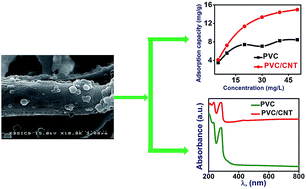Synthesis of PVC/CNT nanocomposite fibers using a simple deposition technique for the application of Alizarin Red S (ARS) removal†
Abstract
This paper reports the synthesis of PVC/CNT nanocomposite fibers using a simple deposition technique as well as their application towards removal of Alizarin Red S (ARS). The as-prepared PVC/CNT nanocomposite fibers were characterized by Brunauer, Emmett and Teller surface area measurements, Raman spectroscopy, X-ray photoelectron spectroscopy, X-ray diffraction, transmission electron microscopy, scanning electron microscopy, thermogravimetric analysis, differential scanning calorimetry and diffuse reflectance spectroscopy. PVC/CNT nanocomposite fibers showed a remarkable 81% increase in surface area compared to the PVC fibers. PVC/CNT nanocomposite fibers showed a lower band gap and higher glass transition temperature than the PVC fibers. Both PVC and PVC/CNT nanocomposite fibers were applied to adsorb ARS and the nanocomposite fibers showed almost double the adsorption capacity than PVC fibers. The thermodynamic study revealed that adsorption of ARS was exothermic in nature and physical forces were involved in adsorption of dye onto PVC and PVC/CNT nanocomposite fibers.


 Please wait while we load your content...
Please wait while we load your content...